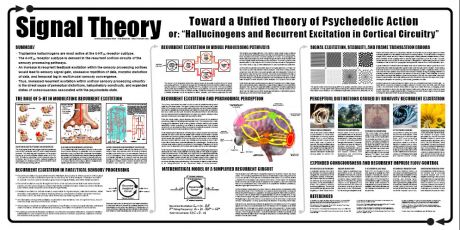Signal Theory Poster
James KentInformational Poster on Hallucinogens and Recurrent Excitation in Cortical Circuitry View PDF of the Signal Theory Poster
The above link will open a 2.7MB PDF of the 4' x 8' informative poster on Signal Theory presented at the 2006 Toward a Science of Consciousness Conference in Tucson, AZ. Adobe Acrobat Reader is needed to view this file. This poster lays out the very basic fundamentals of Signal Theory and how psychedelics promote recurrent excitation in cortical circuits. If you have any questions about the information presented here, you may feel free to contact me at jamesk@tripzine.com.
Background on Signal Theory and Feedback
Since I first tried LSD in the spring of 1988, I have been obsessed with figuring out how psychedelics work. Even though my initial trip was fairly mild, I knew there was something big going on in my head, even if I couldn't expain what it was. I made a conscious decision to do more experimentation with more psychedelics, and vowed to track down every "expert" in the field I could find hoping for clear answers and a deeper understanding of the mystery of psychedelic action.
Over the years, the psychedelic theories I have considered have been numerous and varied, ranging from the pseudo-scientific to the outright metaphysical. There was Leary's 8-circuit model, Lilly's ECCO theory, McKenna's theory of superconductive holgraphic DNA transmission, traditional shamanic mythology, neo-shamanic alien mythology, the Gaia hypothosis, as well as a host of pharmacological theories that asserted psychedelics caused a massive release of "something" in the brain (dopamine? seratonin? acetylcholine?).
As all of these theories trickled into my consciousness I considered it my "duty" to test each and every one for some kind of veracity. I wanted the mystery to be over, yet each time I attempted to test, verify, or utilize one of the above theories in psychedelic practice, I found myself thinking, "Hey, this isn't the right answer." I've summoned aliens, dieties, and demons; I've communed with Gaia; I've activated cicuits in my brain; I've talked to ECCO; and I've meditated deep on the actions of my own brain and DNA, hoping to find some "vision" of truth that answered all of my questions. But the aliens just laughed at me, Gaia shrugged and gave me a hug, ECCO told me the answer was unknowable, and the numerous elaborate configurations of genetics and molecular biology I concocted in my head just didn't add up. Every time I thought I had the answer, I would go back to the psychedelic state for validation, and each time I would be told that I was on the wrong path. Sorry, thanks for playing.
But slowly, over a period of many years, a new theory began to work it's way into my mind. When confronted with the failures of previous models, I went back to square one and began looking at basic properties of the brain that could be utilized to produce such a profound state. The problem was, up until that point I had always thought of consciousness and perception in a very linear way: perception trickles up into consciousness. However, when I began to study feedback pathways within the structure of the brain, everything became very clear. Feedback was the answer. The only property of the brain capable of producing profound expansions of consciousness as well as severe distortions of perception was feedback.
When the notion of psychedelic feedback first struck me it seemed obvious; feedback is used in amplifyers, FX boxes, error correction, recursive algorithms, fractal expression, and genetic expression for that matter. Feedback is the ultimate regulator of signal strength in every medium I could think of, including molecular biology and human social interaction. And the more I studied feedback in the brain, the more I realized how essential it is to the process of everyday consciousness itself. Not only is consciousness a continual feedback loop between perceiver and perception, but the vast majority of axons in the cortex are dedicated to feedback processes that are fundamental to all perception and thought.
When discussing feedback, I can't help thinking of Jimi Hendrix's rendition of the "Star Spangled Banner," a blistering electric guitar solo filled with brain-melting amplifyer feedback. Hendrix's use of feedback both amplifies the guitar sound and extends the decay of each feedbacking wail until the notes begin to pile on top of each other in a howling wash of oscillating noise patterns. With enough feedback amplification, delay, and echo, the wailing notes continue on even when Hendrix is not touching the guitar strings. Once sufficiently primed by noise, the feedback process on Hendrix's guitar quickly enters a stable, self-sustaining state, and would continue ad-infinitum until the feedback oscillation was perturbed in some way. In the case of Hendrix, the feedback oscillation is modulated by his proximity to the amplifyer and his control of his guitar's pickup volume. With this simple use of feedback modulation, Hendrix creates a natural overdrive that extends the range of the guitar and amplifier to a point that seems impossibly extreme. In a sense, the feedback loop pushes the amplifyer into a "expanded state" of functioning, able to produce something far more exotic and unique than a faithful rendering of simple guitar tone (which is what the amplifyer was designed to do). By using feedback, Hendrix essentially "hacked" the amplifyer's circuitry to produce a super-functioning state well beyond its normal range.
Sound familiar?
And so, armed with my new understanding of neural feedback, I approached the psychedelic state again. But this time it was different. As I found myself entering psychedelic consciousness, I was struck by how aware I was of feedback amplifying sensation in my own mind. Indeed, I now recognized feedback as the hidden "driver" of the psychedelic state that I previously could not explain or envision. But now it all made perfect sense. Now, when images stuck in my mind and receded into swirling patterns and noise, I could sense how they morphed and decayed through a progressive feedback cycle, stretching and amplifying through time in the same way Hendrix warped the "Star Spangled Banner" into sonic oblivion. I began to notice how sound echoed and decayed in my head, creating the same exact type of overlapping white-noise phasic feedback sound found in heavily filtered house music. I understood that the use of feedback in music is inherently psychedelic because cortical feedback caused by psychedelics is precisely the effect that Hendrix and acid house DJs were trying to emulate.
Obviously, the notion of psychedelics acting as feedback amplifyers for recurrent excitation in neural circuitry is not as cool as shamanic deities and psychic aliens and holographic DNA projections, but it is infinitely more workable as a practical theory, and it has an extremely solid basis in actual neuroanatomy and pharmacology. The premise of psychedelics acting as feedback promotors in neural circuitry is an extremely simple theory, so simple I was suprised that no one had thought of it before. But after doing some basic research on both 5-HT2A agonists as well as recurrent excitation in cortical circuitry, it became instantly clear that I was onto something. Not only did I have a theory, I also managed to put together a working pharmacological model for the process. As far as I know, what I am asserting in Signal Theory has never been proposed before, and represents a totally new model for understanding psychedelic action in the brain.
Signal Theory may not be complex, but the principle of Occam's Razor suggests that all things being equal, the simplest explanation which answers all the questions is most likely the correct one. Signal Theory does not rely on hidden functions of the brain or invisible spirit entities to explain how psychedelics work, it simply states that psychedelics amplify one of the brain's most essential functions: the use of feedback excitation to process and analyze sensory data.
Some people may feel that Signal Theory is too simple, and may take offense that it essentially reduces the mystery of the psychedelic state to loops of excited sensory data spinning out of control in your head. But after years of careful experimentation, analysis, and research, this is what it has come down to. I don't want to imply that loops of excited data spinning around in your head are a meaningless nothing; obviously that is not the case. The process of excited neural feedback is what allows the mind to expand beyond its normal functioning, becoming something more than what it was strictly designed for. The process of promoting recurrent excitation within neural circuitry is the process of pushing human perception to its operational limit; totally maxing out the network and ramping it up to its fullest analytical potential.
Runaway feedback excitation in cortical lobes may very well be a gateway to transcendent realms and expanded consciousness, but it may also be a gateway to paranoia, delusion, and psychosis. Navigating the warped topography of your brain's excited feedback circuits without blowing your mind on wailing distortion is the art and skill of the shaman, and there is much to be learned about the self and the natural world through this process. Like all scientific theories, Signal Theory does not attempt to explain "why" people get so much out of the psychedelic experience, it only attempts to explain "how" psychedelics work their specific magic, and in that regard I feel I am on very solid footing.
Finally, I would like to thank everyone who has supported me in the process of developing this theory. I could not have done it without donations from hundreds of private individuals willing to take a chance and support my research. I sincerely hope that over time Signal Theory grows into an accepted principle of psychedelic action, and that the insights I put forward here help future explorers reach the highest possible potentials of their own minds. They deserve it!
James Kent
April, 2006¤ Link
Tags : psychedelic feedback hallucinogen perception neuroscience brain cognition
Posted on: 2006-04-03 19:16:06
|


